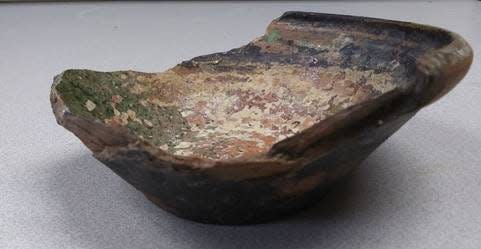Mackinac State Historic Parks Archaeology uncovers two artifacts
MACKINAW CITY— The 64th archaeological field season is barely two weeks old, and already two new finds have been made, the first of which was uncovered May 26.
“Every year, sections of the walls of the excavation collapse over the winter. We had a very nice artifact come out of the east wall of the southeast cellar,” said Dr. Lynn Evans, Mackinac State Historic Parks' curator of archaeology. "It is part of a red earthenware bowl. It appears to have been glazed, but we won’t know for certain until we can clean it in the lab. The base is two and one-half inches in diameter. It was probably discarded during the move to Mackinac Island in 1781."

Then, on June 9, another artifact was found at the excavating site.
“We had a great find come out of the Southeast Cellar,” Evans said. “It is a one-ounce brass weight marked with a crown over GR, for the king. It was used with a balance-type scale.”
More: Pocketknife unearthed at Colonial Michilimackinac on July 4
The base diameter is one and one-eighth inches, the top diameter is one and one-quarter inches, and it is three-sixteenths inch thick.

The current excavation site is House E of the Southeast Rowhouse at Colonial Michilimackinac. Numerous finds have been made at the site in recent years, including a Compagnie des Indes lead seal dating between 1717 and 1769, a brass sleeve button with an intaglio bust on it, a potential structural post dating to the original 1715 fort, an engraved “Jesuit” trade ring, a brass serpentine sideplate for a British trade gun; complete remnants from a creamware plate; and many other items.
More: Archaeology program unearths Michilimackinac treasure
The archaeological dig at Michilimackinac began in 1959, making it one of the longest-running archaeology programs in North America. House E was first occupied by Charles Henri Desjardins de Rupallay de Gonneville, and later by an as-yet-unidentified English trader.
Subscribe: Get unlimited access to all our local coverage
Archaeologists are on site every day at Colonial Michilimackinac, weather permitting, through the summer.
Visit mackinacparks.com for more information about the excavation sites and past artifacts that have been found at these sites.
This article originally appeared on Cheboygan Daily Tribune: Mackinac State Historic Parks Archaeology uncovers two artifacts

